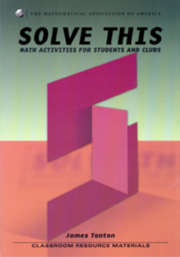Book contents
- Frontmatter
- Introduction
- Contents
- Part I Activities and Problem Statements
- Chapter 1 Distribution Dilemmas
- Chapter 2 Weird Shapes
- Chapter 3 Counting the Odds … and Evens
- Chapter 4 Dicing, Slicing and Avoiding the Bad Bits
- Chapter 5 “Impossible” Paper Tricks
- Chapter 6 Tiling Challenges
- Chapter 7 Things that Won't Fall Down
- Chapter 8 Möbius Madness: Tortuous Twists on a Classic Theme
- Chapter 9 The Infamous Bicycle Problem
- Chapter 10 Making Surfaces in 3- and 4-Dimensional Space
- Chapter 11 Paradoxes in Probability Theory
- Chapter 12 Don't Turn Around Just Once!
- Chapter 13 It's All in a Square
- Chapter 14 Bagel Math
- Chapter 15 Capturing Chaos
- Chapter 16 Who Has the Advantage
- Chapter 17 Laundry Math
- Chapter 18 Get Knotted!
- Chapter 19 Tiling and Walking
- Chapter 20 Automata Antics
- Chapter 21 Bubble Trouble
- Chapter 22 Halves and Doubles
- Chapter 23 Playing with Playing Cards
- Chapter 24 Map Mechanics
- Chapter 25 Weird Lotteries
- Chapter 26 Flipped Out
- Chapter 27 Parts that do not Add up to their Whole
- Chapter 28 Making the Sacrifice
- Chapter 29 Problems in Parity
- Chapter 30 Chessboard Maneuvers
- Part II Hints, Some Solutions and Further Thoughts
- Part III Solutions and Discussions
- References
- Index
Chapter 3 - Counting the Odds … and Evens
from Part I - Activities and Problem Statements
- Frontmatter
- Introduction
- Contents
- Part I Activities and Problem Statements
- Chapter 1 Distribution Dilemmas
- Chapter 2 Weird Shapes
- Chapter 3 Counting the Odds … and Evens
- Chapter 4 Dicing, Slicing and Avoiding the Bad Bits
- Chapter 5 “Impossible” Paper Tricks
- Chapter 6 Tiling Challenges
- Chapter 7 Things that Won't Fall Down
- Chapter 8 Möbius Madness: Tortuous Twists on a Classic Theme
- Chapter 9 The Infamous Bicycle Problem
- Chapter 10 Making Surfaces in 3- and 4-Dimensional Space
- Chapter 11 Paradoxes in Probability Theory
- Chapter 12 Don't Turn Around Just Once!
- Chapter 13 It's All in a Square
- Chapter 14 Bagel Math
- Chapter 15 Capturing Chaos
- Chapter 16 Who Has the Advantage
- Chapter 17 Laundry Math
- Chapter 18 Get Knotted!
- Chapter 19 Tiling and Walking
- Chapter 20 Automata Antics
- Chapter 21 Bubble Trouble
- Chapter 22 Halves and Doubles
- Chapter 23 Playing with Playing Cards
- Chapter 24 Map Mechanics
- Chapter 25 Weird Lotteries
- Chapter 26 Flipped Out
- Chapter 27 Parts that do not Add up to their Whole
- Chapter 28 Making the Sacrifice
- Chapter 29 Problems in Parity
- Chapter 30 Chessboard Maneuvers
- Part II Hints, Some Solutions and Further Thoughts
- Part III Solutions and Discussions
- References
- Index
Summary
A Coin Trick
Han tosses 12 coins onto a table top. He closes his eyes and instructs John to turn over as many coins as he likes. John can, if he wishes, turn over the same coin every time or any number of times, but there is one proviso: Every time a coin is turned John must say out loud the word “flip.”
When finished, John covers one coin with his hand and tells Han it is okay to open his eyes. Han then swiftly, and correctly, announces the state of the coin under John's hand, whether it is heads up or tails up. Han is able to do this correctly every time the game is played, even if a different number of coins is used. What is Han's trick?
Comment. When performing this trick in front of a large group, consider using chips colored black on one side and white on the other rather than coins for better visibility.
Let's Shake Hands
With an odd number of people in the room, ask everyone to shake hands an odd number of times. No person need shake everyone's hand. In fact, each person could just shake hands with the same small selection of people multiple times. All that is required is that every person be involved in an odd number of handshakes. Noting that it is impolite to refuse a handshake when offered (and that shaking hands with yourself is considered invalid), what curious predicament do folks find themselves in when they attempt this experiment?
- Type
- Chapter
- Information
- Solve ThisMath Activities for Students and Clubs, pp. 7 - 8Publisher: Mathematical Association of AmericaPrint publication year: 2001



